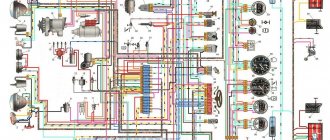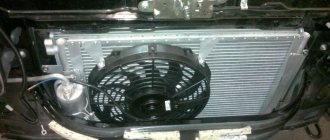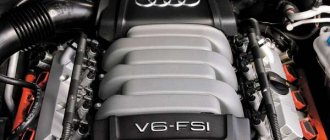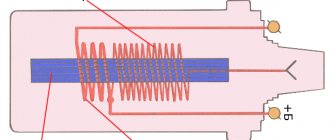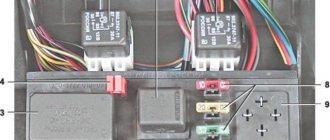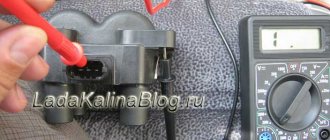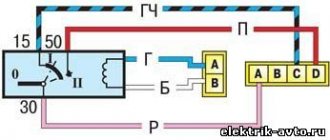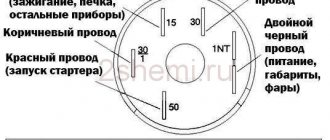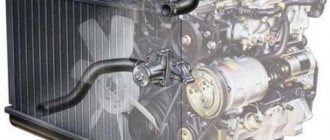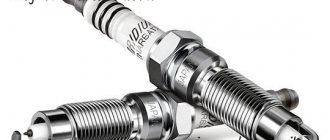This car model was designed on the basis of the 967 model, which was produced for the military industry and had unique characteristics, it was an amphibian with a propeller, the ability to be dropped with a parachute and other characteristics that are not needed in civilian use. The main advantage is that the wiring of the LuAZ 969 is simple, and it is no different from the military version, so it’s not difficult to understand it.
A simple and very passable car is indispensable for off-road use.
Electrical diagram of LuAZ-969M
I - Low beam; II - High beam; III — Sidelight and rear marker lamp; IV - Direction indicator; V-Brake light.
- — Additional side direction indicator;
- — Front right side lamp and direction indicator;
- — Headlight;
- — Connecting block;
- — Front left parking lamp and direction indicator;
- - Sound signal;
- — Oil pressure gauge sensor;
- — Location of the oil temperature indicator sensor;
- — Generator LuAZ;
- — Ignition distributor;
- — Connecting block;
- — Starter LuAZ-969;
- - Spark plug;
- — Battery;
- — Mounting fuse block;
- — Battery switch;
- — Electric windshield wiper motor;
- — Engine compartment lamp;
- — Relay regulator;
- — Starter blocking relay;
- — Relay for signaling the health of the brake system;
- — Additional starter relay;
- — Electric motor of the windshield washer pump;
- - Ignition coil;
- — Electromagnetic valve EPHH;
- — Microswitch EPHH;
- — Brake light switch button;
- — Lamp in the interior lamp;
- — Electronic unit, EPHH control;
- — Plug socket;
- — Turn signal relay;
- — Hazard switch;
- — Central light switch;
- — Three-lever steering column switch;
- - Fuse;
- — Bimetallic fuse;
- - Fuse;
- - Fuse;
- — Ammeter LuAZ-969;
- — Instrument lighting bulbs;
- — Indicator lamp signaling the serviceability of the brake system;
- — Lamp for control of direction indicators;
- — Oil pressure gauge (pressure gauge);
- — Push-button bimetallic fuse;
- — Speedometer LuAZ-969;
- — High beam warning lamp;
- — Oil temperature indicator;
- — Rear axle differential lock control lamp;
- — Fuel level indicator;
- — Switch for the rear axle differential lock warning lamp;
- — Switches for signaling the health of the brake system;
- — Reversing light switch;
- — Push-button bimetallic fuse;
- — Fuel level gauge;:
- — Horn contact;
- - Egnition lock;
- — Rear light LuAZ-969;
- — Reversing light;
- — License plate lamp lamp;
- — Heating installation;
- — Heater temperature switch;
- — Heater glow plug;
- — Heater fan electric motor;
- — Solenoid valve for heater fuel metering;
- — Electric fuel pump heater;
- — Heater control lamp;
- — Heater control spiral;
- — Connecting block;
- — Heater switch.
CAR ELECTRONICS REPAIR
Some features of repair work
If you have any malfunctions, you should fix them immediately. The work is not complicated, because there are no electronics in the system; we will consider only the most general recommendations, without delving into the process.
Maintenance
For work, you will need a simple set of tools and a tester, with which you can quickly and accurately diagnose the system and check the presence of current in a particular node.
In general, here are some tips:
- If the generator does not provide high-quality charging, it is best to replace it, and there can be many options - from VAZ units to foreign cars, the main thing is to choose the optimal configuration of the equipment so that you can get by with a minimum number of alterations, most often you need a bracket, the rest is adjusted locally.
If you are installing a more powerful generator, use this circuit
- When replacing individual cores, be sure to follow the color coding, otherwise it will be difficult to figure out what goes where. That is, if you change the red wire, then replace it with a new product of the same color. When the required option is not available, you can temporarily use what you have, but then be sure to replace it with the correct one.
This connection is not allowed
- Pay special attention to all connections, as they are the most common cause of malfunctions. Twists and electrical tape are unacceptable; you must purchase crimping pliers, install terminals on all ends of the wires, and cover the crimping area with heat-shrink tubing . In some cases, you can make a connection using a soldering iron, but after that it must be carefully tinned and covered with the same heat shrink.
This is what a correctly assembled contact looks like
Replacing electrical wiring
If the LuAZ wiring is in a very poor condition, then it is easier to replace it completely than to work with individual components.
The following can be noted on this issue:
- Finding an original kit is often very difficult, so as a way out of the situation you can use a ready-made wiring kit from a VAZ 2106. It is ideal for doing the job; you just need to understand the diagram in order to understand where each node should be connected. The length of all the harnesses is quite sufficient, and the price of this option is quite affordable.
This is what the wiring kit looks like - of course, you will have to figure it out, but the work is quite within the capabilities of any car owner
Advice! The kit consists of a front, rear harness and panel kit. If you don't need all three assemblies, you can look for them separately, this will save money.
- Before installation, stock up on a sufficient number of special corrugations, which allow you to lay the wiring as neatly as possible and perfectly protect it from moisture, which is very important, because the car is designed for off-road driving, and all its components are splashed with water and dirt much more than in conventional road models .
Underhood wiring hidden in corrugation
- When laying the system, it is best to secure the harnesses with plastic clamps; this ensures the highest reliability and durability of the connections, because plastic does not rot or rust. In addition, if necessary, it is easy to cut the clamps and then install new ones; their cost is just a penny, so you will not incur any extra costs.
- All connectors must be connected tightly and securely fixed, this eliminates loss of contact when moving when the structure is affected by vibration and shaking.
CIRCUIT BREAKERS
The following fuses are used in the vehicle electrical system:
- two thermobimetallic push-button type with a rated current of 20 A to protect the circuits of the heating system, body and engine compartment lighting, power socket, horn and brake warning system; installed on the instrument panel;
- three fusible fuses with a rated current of 6 A to protect the power circuits of instrumentation, a flashlight and a reverse switch and a turn signal relay (separately for the right and left sides), installed on wires under the instrument panel;
- thermobimetallic with a rated current of 3.5 A to protect the power supply circuit of the electric motors of the windshield wiper and washer; installed in the engine compartment on the bulkhead;
- a block of six fuses; installed in the body on the left side under the instrument panel.
Purpose of fuses:
- fuse A (8 A) - circuits of the sidelight and rear light of the left side (side marker), license plate lamp;
- fuse B (8 A) - circuits of the sidelight and rear light of the starboard side (side marker), lighting of instrumentation;
- fuse B (16 A) - left headlight high beam circuit;
- fuse G (16 A) - circuit of the main beam of the right headlight and the control lamp for turning on the main beam of the headlights;
- fuse D (8 A) - left headlight low beam circuit;
- fuse E (8 A) - low beam circuit of the right headlight.
Before replacing a blown fuse, eliminate the cause that caused its failure.
Thermal fuses are activated by pressing a button.
GENERATOR
Generator Maintenance
To ensure reliable operation of the generator during operation, it is necessary to check the serviceability of the generator set using the ammeter on the instrument panel.
Check the radial clearance in the bearings by rocking the drive pulley - the bearings should not have noticeable clearance.
Every 48,000 km it is necessary to remove the generator from the engine, disassemble it, and also check the condition of the brushes and slip rings.
Remove the seals from the bearings and wash them with gasoline, then check their condition. If the bearings do not have noticeable clearance, then they may be suitable for further use. In this case, they should be filled with LZ-31 lubricant to 70% of their volume, otherwise the lubricant may squeeze out the seals. In the absence of the specified lubricant, you can use Litol-24 lubricant, however, the frequency of subsequent addition of such lubricant is no more than after 18,000-24,000 km of the vehicle. Check the condition of the brushes and the ease of their movement in the brush holders. If jamming is detected, stretch the spring or clean the hole.
Check the height of the brushes. Replace brushes with a height of less than 10-11 mm with new ones, having previously ground them to a radius of 15 mm. Clean the contact rings. If carbon deposits are found on the rings, they should be wiped with a clean, lint-free cloth lightly moistened with gasoline. In case of heavy carbon deposits on the rings, clean them with fine glass sandpaper. If there are grooves on the rings, the rings should be sharpened and the brushes replaced with new ones.
LIGHTS
The headlights are equipped with a semi-dismountable sealed optical element, consisting of a reflector, diffuser glass and a flanged double-filament lamp.
Replacement of headlight bulbs must be done in the following sequence:
- remove the outer rim 1 secured with screw 2
- slightly unscrew the screws and remove the optical element, which is secured in the headlight by the inner rim 4;
- remove cover 13 with contacts;
- change the lamp;
- install the cover with contacts, the optical element, secure the inner and facing rims.
Adjusting the headlights FG 122 BV1
FG 122 BV1 headlights with European asymmetric low beam light distribution have a sharp boundary between the light and dark zones. Therefore, headlights must be adjusted very carefully so as not to dazzle oncoming drivers.
To adjust the headlights you need to:
- Place the equipped car with the driver on level ground against the screen located at a distance of 7.5 m from the car.
- Turn on the low beam and rotate two (on each headlight) adjusting screws 9 located at an angle of 90°. install the optical elements so that the boundary between the illuminated and unlit areas runs along line 2, and the inclined segments emerge from the intersection points of lines A and B with line 2, marked in the figure with the sign Each headlight is independently adjustable, and the light from another headlight should not illuminate the screen .
Electrical wiring of LuAZ 969 - important features of the system that you should know
This car model was designed on the basis of the 967 model, which was produced for the military industry and had unique characteristics, it was an amphibian with a propeller, the ability to be dropped with a parachute and other characteristics that are not needed in civilian use. The main advantage is that the wiring of the LuAZ 969 is simple, and it is no different from the military version, so it’s not difficult to understand it.
A simple and very passable car is indispensable for off-road use.
HEATING
What is a contract gearbox
The heating system operates independently of the car engine, which allows it to be used to heat the body when the engine is not running.
Use of the heating system when the engine is not running should be short-term, as the battery may be discharged.
The installation is powered by the same gasoline as the car engine. Rules for turning on and off the heating installation. You can turn on the heating system both when parked and while driving. To enable it you need:
- Pull handle 8 of the switch towards you until the first click is heard.
- Wait 30 seconds, and then move the handle to the second position, pulling it towards you until it stops.
- Monitor (within 45-60 s) the moment when indicator light 20 with a green light filter on the instrument panel lights up. Illumination of the control lamp and its continuous burning indicate normal operation of the heating installation. If the control light does not light up within 1.5 minutes after turning the switch to the second position, the heating installation should be turned off, the fault should be identified and eliminated. To turn off the heating installation, the switch handle must be pushed all the way away. In this case, the control light continues to light for 3-5 minutes and then goes out.
The heating system can only be put back into operation after the indicator light goes out.
To ensure heating of the body and blowing of the windshield, handle 7 of the damper axis must be in a horizontal position.
When the damper axis handle is in a vertical position, the engine will be heated.
The supply of heated air to the area where the driver and passenger’s feet are located or to the windshield is adjusted using handle 17 of the distributor damper.
The heater is powered by an electric fuel pump BN-200A2, installed in the engine compartment under the heating installation.
The heating system switch has three switch positions:
- off (handle recessed completely);
- start-up (electric motor, heater glow plug and control spiral included);
- fuel supply (additionally included solenoid valve and solenoid pump).
Maintenance of the heating installation is carried out seasonally (in preparation for autumn-winter operation), and also as needed.
Seasonal maintenance of an electromagnetic fuel pump:
- remove from the car and clean from dust and dirt;
- remove the cover with fittings, rinse and clean the valves;
- if necessary (in case of interruptions in the operation of the pump), remove the cover of the contact system and check the condition of the contacts;
- restore the elasticity of the diaphragm (stretch it with your fingers);
- clean and rinse the sediment filter.
Seasonal heater maintenance:
Gasoline supply regulator. Rinse the filter, clear the float chamber of sediment, check the tightness of the shut-off needle, and blow out the nozzle with compressed air. Heat exchanger. Clean the glow plug from carbon deposits and blow it with compressed air. Blow the heat exchanger with compressed air through the spark plug hole to remove soot deposits. If there is a lot of soot in the exhaust pipe, you should completely remove the heat exchanger and, by tapping the body with a copper object, knock off the soot and blow it out with compressed air. Clean the drain pipe using a metal cleaning rod and also blow it out with compressed air. When installing a glow plug into the chamber, the axis of the spiral must be parallel to the axis of the heater. Gas outlet. Clean from dust and soot
Pay special attention to the safety of the metal-asbestos gasket between the exhaust pipe flange and the gas outlet. Blow out the fuel supply line and drain hose with compressed air, being sure to disconnect it from the regulator.
The following types of maintenance are performed as necessary:
- Clean (bleed) the nozzle by first unscrewing it from the gasoline supply regulator.
- Clean the glow plugs if carbon deposits form.
- Clean the heat exchanger and gas outlet from soot.
- Remove the electric motor, check it, lubricate the bearings.
- Wash the collector with gasoline or alcohol.
It is advisable to carry out troubleshooting and maintenance at a service station.
ELECTRICAL DIAGRAM OF THE CAR I LuAZ 969 M - March 1991
- Online Archive
- Forum
- Wiki
- Buy a car
- Magazine “Behind the wheel”
- Online store
Transmission
To come in
- Announcements
- Editions Behind the Wheel
- Newspaper "Behind the wheel - Region"
- Buy a car
- Moto
- Flight
- New items
- All brands
Search
- Announcements
- Behind the wheel
- Newspaper "Behind the wheel - Region"
- Buy a car
- Moto
- Flight
- Books and catalogs
- Makes and models
- Search
- ZR 2018
- ZR 2017
- ZR 2016
- ZR 2015
- ZR 2014
- ZR 2013
- ZR 2012
- ZR 2011
- ZR 2010
- ZR 2009
- ZR 2008
- ZR 2007
- ZR 2006
- ZR 2005
- ZR 2004
- ZR 2003
- ZR 2002
- ZR 2001
- ZR 2000
- ZR 1999
- ZR 1998
- ZR 1997
- ZR 1996
- ZR 1995
- ZR 1994
- ZR 1993
- ZR 1992
- ZR 1991
- ZR 1990
- ZR 1989
- ZR 1988
- ZR 1987
- ZR 1986
- ZR 1985
- ZR 1984
- ZR 1983
- ZR 1982
- ZR 1981
- ZR 1980
- ZR 1979
- ZR 1978
- ZR 1977
- ZR 1976
- ZR 1975
- ZR 1974
- ZR 1973
- ZR 1972
- ZR 1971
- ZR 1970
- ZR 1969
- ZR 1968
- ZR 1967
- ZR 1966
- ZR 1965
- ZR 1964
- ZR 1963
- ZR 1962
- ZR 1961
- ZR 1960
- ZR 1959
- ZR 1958
- ZR 1957
- ZR 1956
- ZR 1955
- ZR 1954
- ZR 1953
- ZR 1952
- ZR 1951
- ZR 1950
- ZR 1949
- ZR 1948
- ZR 1947
- ZR 1946
- ZR 1945
- ZR 1944
- ZR 1943
- ZR 1942
- ZR 1941
- ZR 1940
- ZR 1939
- ZR 1938
- ZR 1937
- ZR 1936
- ZR 1935
- ZR 1934
- ZR 1933
- ZR 1932
- ZR 1931
- ZR 1930
- ZR 1929
- ZR 1928
- №1
- №2
- №3
- №4
- №5
- №6
- №7
- №8
- №9
- №10
- №11
- №12
- To review the issue
- 0 — ISSUE COVER
- 0 - CROSSROADS OF OPINIONS
- 0 — CONVERSION: WILL WE WIN OR LOSE?
- 1 - MODERN AUTOMOBILE ENGINEERING
- 2 - CAR AND SOCIETY
- 3 - CROSSROADS OF OPINIONS
- 4 - WHEEL
- 6 - THE PATH TO TRIUMPH
- 8 – EXPERIENCES “BEHIND THE DRIVING”
- 9 – EXPERIENCES “BEHIND THE DRIVING”
